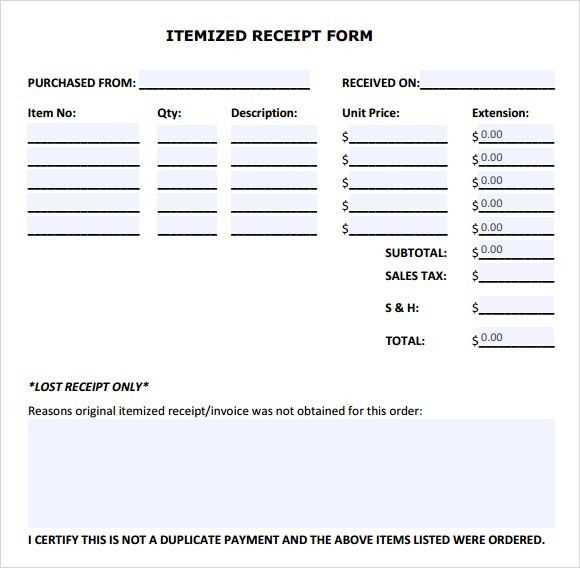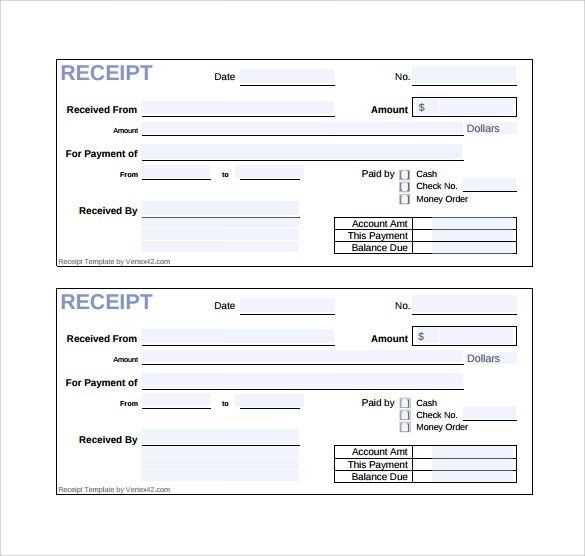
To create a court receipt template, focus on clarity and simplicity. Begin with a header that clearly states the purpose of the document–such as “Court Receipt” or “Receipt for Payment of Court Fees”. This establishes the function of the receipt at a glance.
Include the court’s name and address at the top, ensuring that the contact information is easy to find. Follow this by the case number and the date of payment, which are critical for record-keeping and future reference.
Next, list the specific fees paid, including any applicable breakdowns (e.g., filing fees, processing fees). Each fee should be clearly labeled with an accompanying amount paid and the method of payment (e.g., credit card, check, or cash). A summary of the total payment should appear at the bottom of the list.
Finally, provide space for the signature of the court clerk or the responsible official to confirm the payment. This adds authenticity to the receipt and confirms that the transaction has been processed correctly.
How to Create a Legally Compliant Court Receipt Template

To create a legally compliant court receipt template, begin by including key details that confirm the transaction and provide transparency. These should include the full name and contact information of the court or relevant authority issuing the receipt, as well as a unique reference number for the transaction.
Required Information

Ensure the receipt lists the date of the transaction and specifies the type of payment received–whether it’s a fine, filing fee, or another court-related charge. Clearly state the amount paid and the method of payment (e.g., cash, cheque, credit card, etc.). If applicable, provide a breakdown of costs and any discounts or credits that apply to the payment.
Legal Compliance Features
Ensure your receipt includes a statement that confirms the payment has been received in full and that no further actions are required for this specific transaction. This statement should be clear and concise to prevent any confusion or ambiguity regarding the status of the payment.
In addition, the receipt must be signed by the appropriate authority–whether that’s the court clerk, a judge, or another official. If electronic receipts are issued, include a secure signature or verification method to authenticate the document.
Lastly, verify that the receipt aligns with local legal requirements regarding document retention and data privacy, especially if personal or financial information is collected. This will ensure that your receipt remains both legally valid and compliant with regulations.
Common Mistakes to Avoid When Drafting a Court Receipt

Always ensure you include the full legal name of both the payer and the recipient. Omitting full names or using abbreviations can lead to confusion or disputes about the authenticity of the transaction.
Double-check the payment amount and currency. Mistakes in figures or failing to specify the currency can result in delays or legal complications, especially if the transaction involves international parties.
Do not forget to include a detailed description of the transaction. A vague reference to the payment purpose can cause misunderstandings, making it harder to resolve any future disputes related to the payment.
Ensure the date is accurately recorded. Missing or incorrect dates may affect the receipt’s credibility and could be questioned during legal proceedings.
Check the receipt’s numbering system. If you issue multiple receipts, each one must have a unique number for tracking purposes. Reusing numbers can create confusion and lead to issues with record-keeping.
Do not neglect the signature or seal if required by the court. Even if a receipt seems valid, it may not be considered official without the necessary signatures or stamps to confirm its authenticity.
Finally, verify that all relevant terms and conditions are outlined clearly. Failure to do so can leave room for misinterpretation of the payment’s scope or any agreements tied to the receipt.
Practical Uses of Court Receipt Templates in Legal Processes
Court receipt templates are indispensable for recording financial transactions in legal settings. These templates streamline the documentation of payments, fees, and fines during proceedings. By using a standard format, they reduce errors and help ensure accuracy in financial reporting.
Clear Record Keeping

Using a court receipt template guarantees clear, consistent records of payments made to the court. Each entry is properly documented, showing the amount paid, the purpose of the payment, and the recipient. This helps avoid confusion or disputes regarding financial transactions during legal proceedings.
Improved Efficiency in Financial Management

Standardized receipt templates speed up the process of recording payments. Legal professionals can quickly issue receipts without having to create a new document from scratch each time. This saves time and ensures that the payment information is captured in a uniform format, making it easier to track and reference later.


